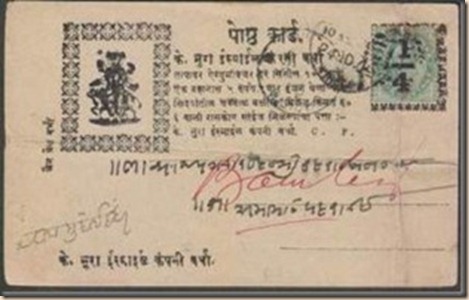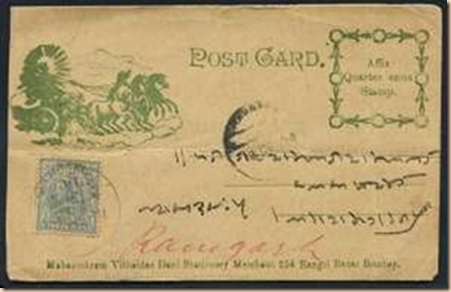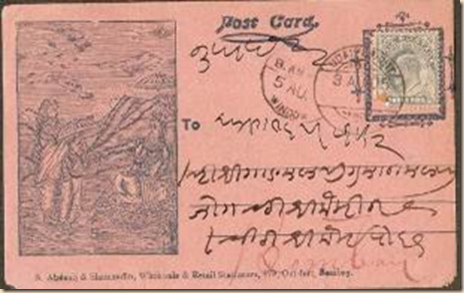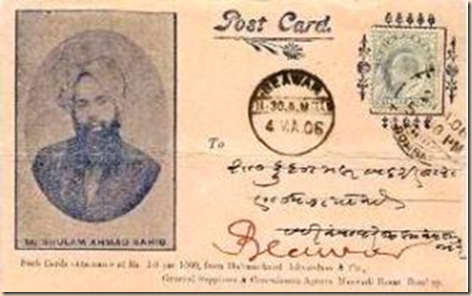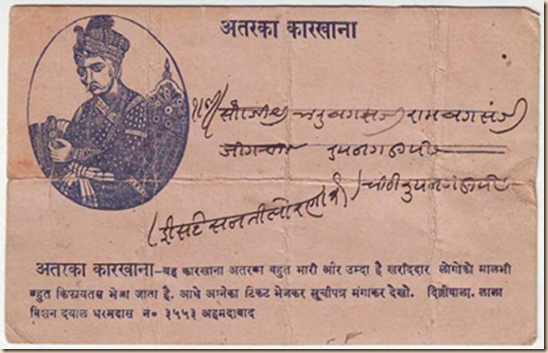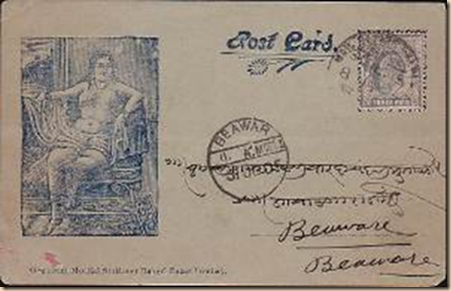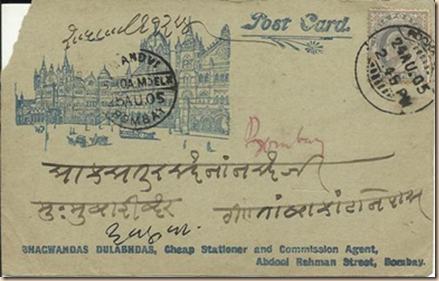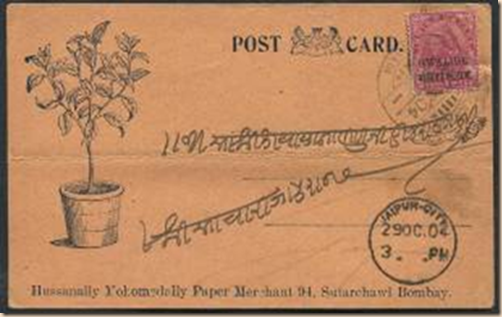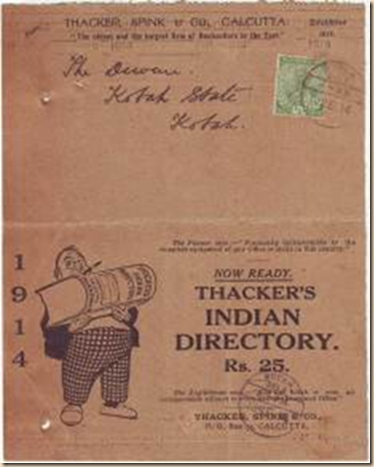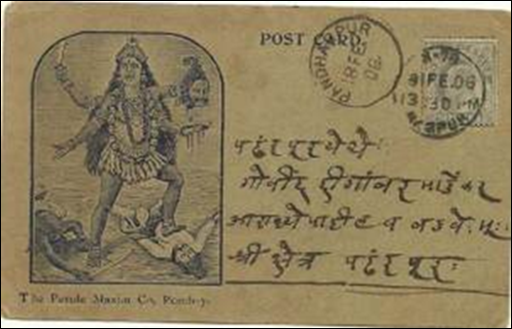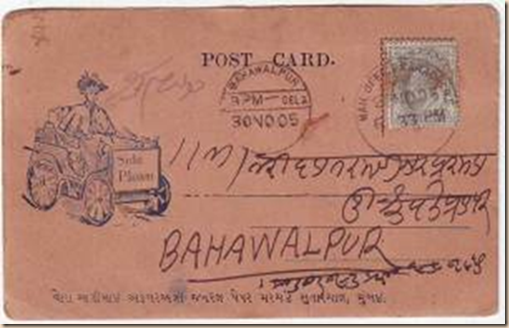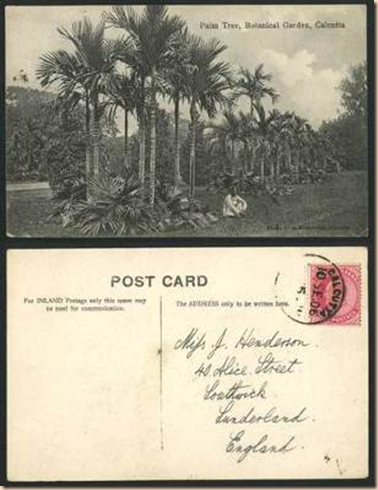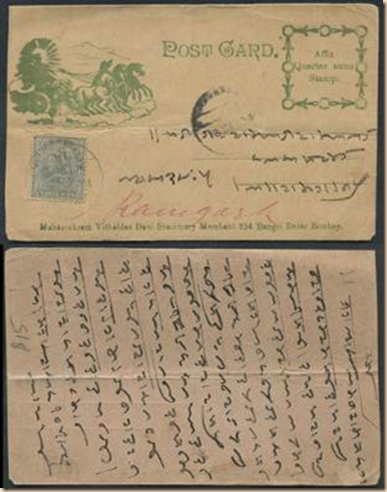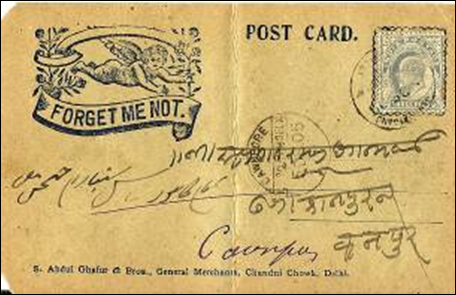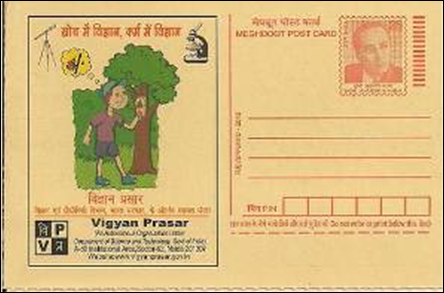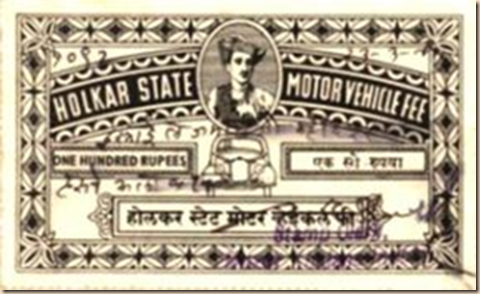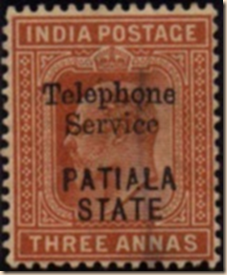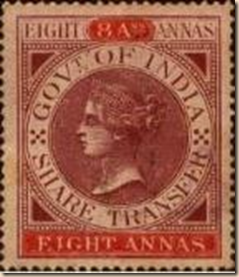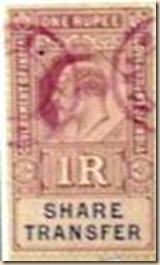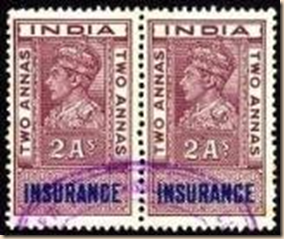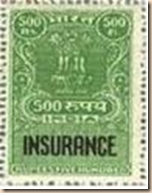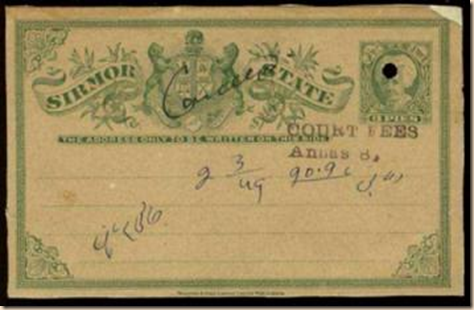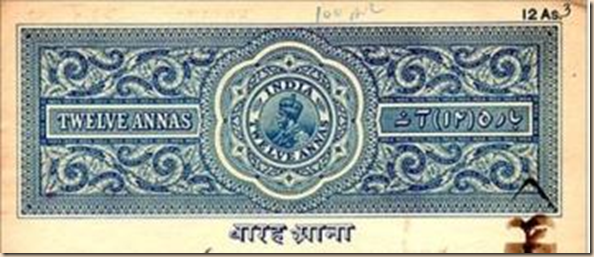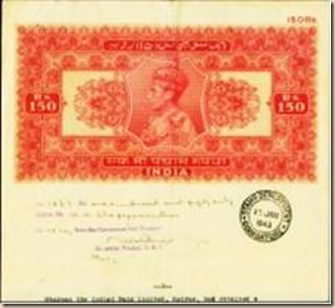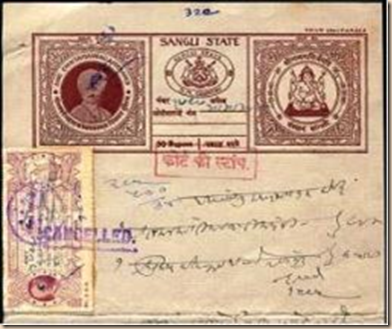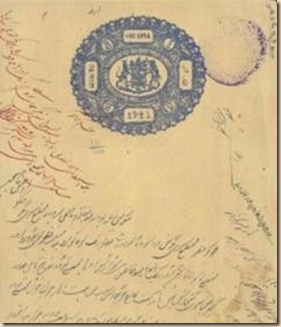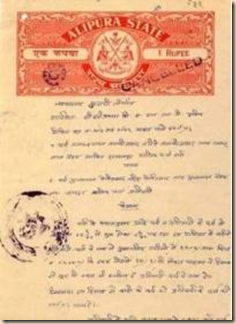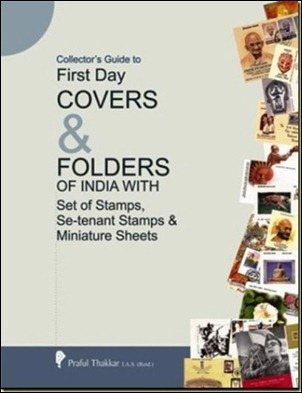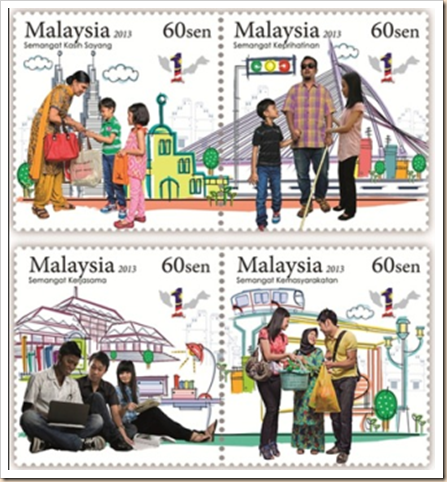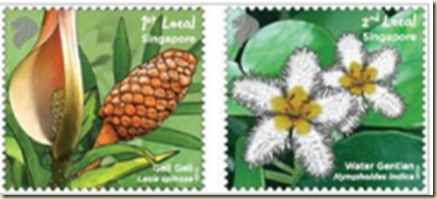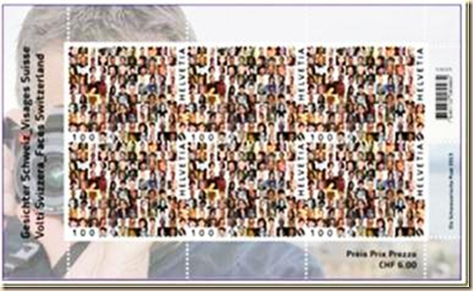Europa 2013 : The Postman Van
Date of Issue : 21 May 2013
Se-tenant pair issued by LaPoste (France) : Mail van (1840 – 2013)
Shimla April 2013 Vol. VI Issue # 64
Monthly e-Stamp Bulletin Edited by Jeevan Jyoti for free circulation among philatelists
Readers are requested to send reports of philatelic activities in their area for publication. Short write ups by the readers about their journals, societies, publications and philatelic requirements can be sent for inclusion in this bulletin to j.jyoti9@gmail.com or rainbowstamp2008@gmail.com and by post to –
Ms. Jeevan Jyoti, c / o Mr. Ajay Srivastav, CCF, GHNP & Pin Valley National Park, SHAMSHI, Kullu -175126. (H.P.) India
Note- This bulletin is only for circulation among a limited group of philatelists without any commercial purpose. The bulletin will be sent to the readers only on request. Those who wish to receive it regularly please reply giving the name of your city / country with the subject SUBSCRIBE RAINBOW
Dear Reader,
The March month ends up with many district level philatelic exhibitions all over the country. This is the time when Department of Posts organizes stamp exhibitions in different circles in hurry at the closing of annual financial year. In fact, these exhibitions are forcefully organized by the department without any set rules and regulations. To mark the show the special covers are issued which are usually sponsored by local organizations or public sectors. These exhibitions are not organized for the promotion of philately but more to do it on paper and complete the official formality .The dates are announced all of sudden and exhibits are collected in a short time from local philatelists to cover 15 - 20 frames .The standard of such exhibitions is very poor. The proper publicity about these exhibitions is not given.
The time of these exhibitions is very unsuitable as most of the schools conduct final examinations in the month of March and students are not able to attend these exhibitions. The Department of Posts should organize such shows at the proper time when students can visit and actively participate in the exhibition. The local philatelic clubs, societies and the philatelists should be associated in these exhibitions so that philatelic workshops and other activities could be organized to promote the hobby of philately. Good award winning exhibits from noted philatelists must be displayed in these exhibitions so the new comers can have a glimpse of good and presentable exhibits. The show must be announced 2-3 months before and the organizers should organize meeting for the exhibition with local philatelists. This used to be a tradition 10-15 years ago but today it is not being followed by most of the circles and they organize a flop show doing a formality of the exhibition. The exhibitions could be well organized and managed only when local philatelists are involved and they become the part of the organizing committee created by the Department of Posts !!.
This is all for this month…More in next issue…..…..Happy Collecting !!
--Jeevan Jyoti
Contents
· From the Desk of Naresh Agarwal
· Recent Indian Issues
· The National Philatelic Champion reveals the story of success…
· In The News
· Interview
· Beginners’ Section
· Specialized Section
· Book Review
· New Issues from Other Countries
· The Lighter Side
· Philatelic Clubs and Societies
· Blogs & Websites on Philately
· Literature on Indian Philately
· Editor’s Mail Box
· Acknowledgement
· Current Philatelic Magazines – Newsletters
·  From the Desk of Naresh Agarwal
From the Desk of Naresh Agarwal
USE OF FISCALS IN THEMATIC PHILATELY
In the last bulletin of Rainbow Stamp News, I read article of Col. Dutta of Fiscals and Revenue. It reminded me of one of my articles published long back in various philatelic magazines entitled “Use of fiscals in thematic philately”. The article discussed about inclusion of fiscals in thematic exhibit. It is clearly seen that now thematic philately is the most liked and appreciated field of philately today. Most of the new philatelists enjoy the essence and fragrance of this field. It is now being widely accepted all over. It is evident that with the passage of time thematic philately has also changed its scope, contents, components and requirements. Thematic philately gives emphasis to the thematic element through variety of philatelic materials such as stamps, cancellations, covers, booklets, advertisements, post marks etc.. There is no limit to the material which can be discovered and used in thematic exhibit suiting to the theme adding to both thematic and philatelic elements.
In the recent years fiscal philately is getting quite prominence. Lots of articles are being published in various philatelic magazines. There is great sale of fiscal material in every philatelic auction and also in exhibitions. Displays in philatelic shows too have started contribution of fiscals in one way or the other. Let’s not forget, fiscal were in existence prior to the birth of postage stamp. In various places postage stamps were used as payment of revenue and vice versa. Both national and local entities have issued them. In certain periods governments have combined the usage of postage and revenue stamps, calling them "postal fiscals" or inscribing them "Postage and Revenue".
In National and International exhibitions various criterion/systems have been used /evolved to evaluate the exhibit such as knowledge, development, reality/originality, rarity, completeness, research etc. have even seen fiscals being used in various quality exhibits for completion and to add variety. Though guide lines for the evaluation of the exhibits of thematic philately for competitive exhibitions such as General Regulations for the Evaluation at FIP Exhibitions (GREV) and the Special Regulations for the Evaluation of Thematic Exhibits (SREV). do not specify anywhere the restriction on usage of fiscals ; one can use a certain percentage of the fiscal material, say 2 to 3 percent but in most befitting manner to see that those items are essentially required for completion of storyline.
I myself have used fiscals in my exhibit on “AUTOMOBILES’ which has won several National and International awards. Initially I used those with a great sense of uncertainty of my exhibits getting degraded as the usage such material was not confirmed. Also no one has even till today spoken / commented authoritatively on this. I even discussed and wrote to various eminent philatelists or judges who either remained silent or replied in very unsatisfied, confused and unclear way. This lead me to a state of confusion. However, I used a little percentage of fiscal in my exhibit in a most befitting manner. But now, my confidence has developed as my inclusion of such items has not affected by evaluation even at international level. However, I understand that fiscals or revenue stamps can be better appreciated as long as these are postally used or have postal validity. These can be admitted in exceptional cases, when these are the only mean to describe any thematic point.
Now coming to the point, as fiscal philately is now a fast emerging, upcoming and recognized field of philately. Its materials do have some thematic importance because at certain level they cover thematic aspects too. It is felt that at lower level competitions, the inclusion of fiscals may not be appropriate / appreciated but at higher level it should be appreciated because it comes in to picture only when specialization is required and also when less philatelic material is available on the subject or its suits to the requirements of the theme. For example, in my collection, I have used 8annas motor vehicle fee stamp of Indore state, registration certificate of 1957 of a car by RTO Bombay affixed with Rs.6/- stamp, Tax token of 1931, federal Motor vehicle tax stamps to cover the subject under Motor vehicle Legislation and Administration which is very important and essential chapter when we discuss about automobiles. But this has been used in a most appropriate and befitting manner. I have seen fiscals being used on the introduction page of an internationally renowned exhibit on FLAGS of Mr. R. Binani who is an eminent philatelist and one of the jury in national level exhibitions. There are so many other examples too where in fiscals have found place in highly acknowledged thematic exhibits..
From the above discussion, I want to say that thematic philatelists even now afraid to use even small percentage of fiscals in their exhibit because of deduction of marks during evaluation of the exhibit considering the inclusion being invalid and improper only because there are no specific and clear guidelines. There is no doubt that the inclusion of fiscals reflects the research, originality and the quality of the exhibitor. In nut shell, although the fiscals are used in thematic philately but I understand that there is no clear official acceptability of the usage of fiscals in thematic exhibits as per FIP/FIAP. Hence, the matter needs to be seriously viewed and officially included in FIP/FIAP rules for evaluation of the thematic exhibit and clear cut acceptance should be given by FIP/FIAP specifying the quantity in percentage and nature of fiscals permitted to be used.
- Naresh Agarwal – email : nareshkumar1992@yahoo.co.in
Recent Indian Issues
· 3 January 2013 - 100 Years of Science Congress of India
· 7 January 2013 - Post Graduate Institute of Medical Education and Research, Chandigarh – Rs 5
· 8 January 2013 - 125 years of Uttar Pradesh Legislature – Rs 5
· 8 January Ghadar Movemnet – Rs 5
· 11 January 2013 – Silk Letter Movement – Rs 5
· 12 January 2013 - 150th birth anniversary of Swami Vivekananda – 3 x Rs 5 + Rs 20 + sheetlet
· 13 January 2013 - C. Achyutha Menon – Rs 5
· 14 January 2013 - Aditya Vikram Birla – Rs 5
· 22 January 2013 - Shrine Basilica,Vailankanni – Rs 5
· 2 March 2013 - 3 Para (Special Forces) – Rs 5
· 7 March 2013 – Officers Training Academy at Chennai – Rs 5
· 16 March 2013 – Malayala Manorama – Rs 5
· 17 March 2013 – Jhulelal Sahib – Rs 5
· 22 March 2013 - Shiv Ram Hari Rajguru = Rs 5
Recent Special Covers
25 March 2013 Auckland House School, Shimla - Shimla
25 March 2013 Rothney Castle, Shimla – The Home of A.O. Hume – Shimla
25 March 2013 Shanti Stupa, Dhauli – Bubaneshwar
26 March 2013 White Tiger – Nadanakanan Zoological Park – Bhubaneshwar
23 - 24 March 2013 Spring Festival – Dehradun
21 March 2013 Shri Chamunda Devi Mata Temple, Kangra - Dharamshala
21 March 2013 Mata Jwala Mukhi Temple, Kangra – Dharamshala
21 March 2013 Serve the Girls Child - Jamshedpur
20 March 2013 Tata Steel - Jamshedpur
India Post, HPO, Allahabad has issued a set of 6 Special Place Covers on Maha Kumbh, 2013.
14 January Makar Sankranti
27 January Paush Poornima
10 February Mauni Amawasya
15 February Basant Panchami
27 February Magh Poornima
10 March Maha Shivratri
These covers are available with Mr Ambarish Kumar Allahabadi email: moni_kumar20@rediffmail.com Ph :9305478831
Stamp Booklet
A stamp Booklet on Swami Vivekanada was issued during JAMPEX 2013, Jamshedpur.
New Pictorial Cancellation from Germany
On 1st May 2013 a new pictorial cancellation will be issued in 89168 Niederstotzingen,GERMANY. The cancellation is featuring a Mammoth. Interested philatelists may please contact : Wolfgang Beyer,Vice Chairman of the German Philatelic Collector Group ARGE ZOOLOGIE. Mail: Wolfgang.beyer1@aol.de. Postage rates: 0,75 Euro AIRMAIL ,2,80 Euro Registered AIRMAIL.
The National Philatelic Champion reveals the story of success…
Special Interview with Dinesh Sharma
It is a great pleasure to share here views of Dinesh Sharma who recently won National Philatelic Championship Award at INPEX 2013 held in Mumbai. I would like to remind the Readers that in the history of National Stamp Exhibitions of India a thematic exhibit has won the highest award for the first time .Dinesh Sharma answers here some of my questions which readers would like to know from a champion and he gives tips to the Thematic Collectors “ How to form the best thematic exhibit ” !!..- Editor
With the Olympic Rings from the Olympic Museum at OLYMPEX – 2008, Beijing Olympics, China
Q1. How do you feel at your great achievement of winning National Championship Award at INPEX 2013 ?
A. When I applied for the Championship Class for INPEX – 2013, I had only one thought that my participation will put me in the list of participants of Championship class. My previous experiences never tempted me to think to be a winner against traditional or postal history exhibits of high repute. Since I entered in the Championship class I did some improvement wherever it was possible financially or otherwise.
Due to some important work I returned to Lucknow on 23rd February, 2013. When one of my friends informed me on phone that my name has been shortlisted for the Championship, I did not believe. Soon my phone rang a few more times. And after hearing the same information from different friends, I started feeling that I have reached closer to the Award.
Honestly, I was still not believing that I would be declared winner but a great feeling was definitely there that it is sure that I would be the runner up. At 5.25 P.M. my friend Sandeep Chaurasia called on phone and asked me to listen carefully. He said that the voting is over and my name is going to be announced. I told him that he would be proved wrong, but it was unbelievable when I heard Mr. Dhirubhai Mehta announcing my name as the winner of Championship.
Q2. What next after winning National Championship Award ???
A. I would like to build my exhibit to win at least a Gold medal at FIP World Level. The objective even before winning the National Championship was also the same. But after winning the National Championship, winning the world Championship or Grand Prix would be the most pleasing achievement. How far I would go only time will tell.
Q3. It is the first time in the history of Indian Philatelic Exhibitions that a Thematic Exhibit has been awarded such a big award ..How do you think the future of different classes of philately ?? Which is going to extinct and which is going to dominate ??? Your comments...
A. I have come to know through different sources that it is first time that a thematic exhibit has won the championship in India. When I started my thematic exhibit there were not many high class thematic exhibits in India and thematic philately was almost at its infancy at that time. In recent decade several philatelists have developed good thematic exhibits but thematic philately in India still needs more attention for its upliftment to compete at world level.
The future for thematic class is bright as thematic philatelists have wider scope for enjoyment through innovation and development of the selected subject. No class of philately is going to extinct. The dominance of traditional philately seems to be remaining as it is.
Q4. You are now National Champion. Would u like to mention some names who supported you to reach this height in philately.In the long journey of philatelic achievements who has been your ideal in philately?
A. There have been many people who supported me in one way or the other to accomplish this achievement. Dr. S.P. Gupta, Late Mr. S.P. Chatterjee, Late. Brigadier Virk, Late Mrs. Betty Van Tennac from Australia, Late Mrs. Francisca, Mr. Yogesh Kumar, Mr. Rajesh Bagri, Mr. Binani and Mr. Maurizio Tecardi have been great supporters in addition to my family members. I would try to write in detail soon how all the people helped me in my venture.
Late Mr. D.N. Jatia (FIP President), Mr. Juan Antonio Samaranch (President International Olympic Committee) Mr. Maurizio Tecardi (secretary General FIPO) are my ideals.
Q5. What is the main reason of choosing Olympic Games as your favourite theme ?? It is a wide theme don't you think it is quite difficult to develop this theme ??
A. I was always fascinated by sports and I wanted to be a great cricketer but never got support from family to take up cricket seriously. I was very keen for stamp collecting too and my interest for sports never died. I started collecting stamps on sports. When I came to know that Olympic Games are the biggest sporting events on earth I started concentrating on collecting Olympic stamps.
In 1980 I got a chance to visit the INDIA – 80, World Philatelic Exhibition held in Delhi (this was first philatelic exhibition I ever visited). It was just like to be lost in the ocean of stamps for me. I saw a few high class exhibits on Olympics and they left a very high impact on me and I decided that one day I would definitely have an exhibit of such high standard in my life.
Q6. What is your other theme on which you are concentrating ?
A. My another theme is “SPORTS IN THE MODERN WORLD”, Which has won a Large Silver Medal at INPEX – 2013. This exhibit has also been awarded a Silver medal at ‘OLYMPEX – 2008’, World Olympic and Sports Philatelic Exhibition held at Beijing Olympics in 2008. I would work to raise standard of this exhibit as best as possible in coming years.
Q7. Besides Thematics which other class you appreciate in philately or collect on it ??? I mean besides Thematics what else you collect ??
A. Besides Thematics I like the ‘Postal History Class’ as in my opinion it provides more opportunity of research and involvement. In fact an advanced thematic philatelist needs to be involved in all branches of philately and he /she develops a habit of appreciating all of them.
I collect India, Australia and Nauru traditionally. All these three countries have special importance in my life, therefore I collect stamps and other philatelic materials from these countries. They are basic collections only.
Q8. Please Give tips to Thematic philatelists to make best thematic exhibit.
A. In my opinion following tips would help the thematic philatelists:
a. First of all never consider Thematic Philately as the easiest branch of philately. Developing a good thematic exhibit takes many years.
b. Patience is the key to success. Finding most suitable philatelic items is not easy and it may take years to find an item even worth a few rupees only. On the other hand a lot of expensive items you need are available, but you don’t have money to buy. Wait patiently and who knows you may get enough money one day to acquire all these highly priced items required by you.
c. Go through as many different thematic exhibits in an exhibition as it would enrich your knowledge to develop your exhibit in a better way. Unfortunately philatelists are found most of the time in the bourse section of a philatelic exhibition.
d. Don’t just start working few weeks or few days before to prepare your exhibit. Developing a high class exhibit is a continuous process and requires a lot of time.
e. Interact with thematic as well as other philatelists. I know that in general the traditional philatelists would not appreciate discussing much about your theme, but listening to their experiences may help you to search better material for your exhibit.
In 2010 at Bangkok-2010 in Bangkok, one Chinese traditional juror gave me some tips very honestly, which helped me considerably in improving my exhibit just by shifting material suitably.
f. Never consider that Jury members do not have knowledge about your subject. Yes, it is not possible for anybody to have detailed knowledge about each and every thing. It is the duty of the exhibitor how better he/she describes and highlights his/her subject. Recently I had a chance to judge an exhibit at a regional philatelic exhibition, I found one exhibit titled as ‘Spices of India’. This exhibit has just two pages showing the spices, while other pages had stamps on birds, aeroplanes and all kinds of stamps without any reference to its title. It was difficult to understand how a senior educated philatelist could do so. In every exhibition you may come across one or two such exhibits. Therefore regular educations through seminars and workshops are necessary.
Never try to befool the judges or viewers by putting fancy item or information. You would be penalized heavily. If you do something wrong unknowingly, the judges would not be that harsh.
Q9. Your most memorable experience in your philatelic journey.
A. There are many memorable experiences in my philatelic journey. The most memorable are as follows:
a. Participating in ‘OLYMPHILEX – 85’ World Olympic Philatelic Exhibition held at the headquarters of International Olympic Committee in 1985. It was my international debut.
b. Invitation to exhibit in ‘Court of Honour Class’ at “SPORTASIANA- 86” International Sports Philatelic exhibition held as a part of 1986 Asian Games.
c. Participating in ‘OLYMPHILEX – 1988’ World Olympic Philatelic Exhibition held for the first time as a part of 1988 Seoul Olympic Games.
d. Winning the Gold Medal at INPEX – 2008
e. Winning the National Championship at INPEX – 2013.
Q10. Your favourite philatelist in India whom you admire most ??
A. Late Mr. D.N. Jatia and Late Brigadier Virk.
Mr Dinesh Sharma may be contacted at email : olymp_sharma@rediffmail.com
In The News
Peru - India Joint Issue
Peru Post issued a pair of stamps to commemorate 50 years of establishment of diplomatic relations between India and Peru on 25 March 2013. The stamps show two of the seven wonders of the world , Machu-Picchu Mountains on one stamp and other one with Taj Mahal. The date from India Post for this joint issue is yet to be announced.
Belgium introduces chocolate-flavoured postage stamps for Easter
FEEL LIKE having chocolate at Easter in Belgium? Well, send a letter and really lick that chocolate-flavoured postal stamp.The Belgian post office released 538,000 stamps yesterday that have pictures of chocolate on the front – but the essence of cocoa oil in the glue at the back for taste and in the ink for smell.
Belgian stamp collector Marie-Claire Verstichel said while the taste was a bit disappointing, “they smell good.” Easter is the season for chocolate in Belgium with Easter eggs and bunnies all over supermarkets and specialty stores.A set of five stamps costs €6.20 .
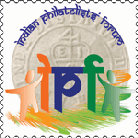 Indian Philatelists’ Forum, a web based forum on yahoo groups, has come out with an innovative idea of creating online directory of Philatelists. This directory is intended to facilitate networking among philatelists and members of forum.
Indian Philatelists’ Forum, a web based forum on yahoo groups, has come out with an innovative idea of creating online directory of Philatelists. This directory is intended to facilitate networking among philatelists and members of forum.
Online Directory of Philatelists
The Directory of philatelists is divided in to two categories. (i) Philatelists residing in India (ii) Philatelists residing abroad and collecting on any aspect of Indian Philately.
An online directory is available on forum’s website www.indianphilately.net. Indian Philatelists’ Forum respects privacy of its members and that’s why directory information is accessible to registered members only. Username and password has been allotted to each member.
A web based data form is now available on forum’s official website www.indianphilately.net and free registration is open.
International Philatelic Exhibitions
THAILAND 2013 - World Stamp Exhibition
THAILAND 2013, International Philatelic exhibition will be held in Thailand from 2 to 14 August 2013 in Bangkok, under the patronage of FIP. The World Philatelic Exhibition will take place from 2 - 14 August 2013 at the Royal Paragon Hall 1-3, 5th floor, Siam Paragon, Bangkok. Mr. R D Binani as Commissioner for India, his address :33-B Rowland Road, Kolkata 700 020 E mail : binanipm@gmail.com Mob:9830073058
Website : www.thailand2013.com
Accepted list of Indian Participants at Thailand 2013
National Commissioner : R.D. Binani
Class / Exhibitor/ No. of Frames / Exhibit Title
4 Virendra Sharma 5 British India Queen Victoria Postal Stationery
8 Pradip Mohanty 5 Bills
9 Amil Suri 8 Fiscals of Cochin
10B Mrinal Mathur 5 From Wheel To Car
10C Chiranjib Chakraborty 5 Transportation Modality - The Modes of Transportation
11A Bibhudatta Mishra 0 Dakatikata Sangraha
3B Om Prakash Kedia 5 Development of Indore Post (1873-1908)
7A Lallan P. Singh 5 Hows and Whys of Birds
7A Birajlaxmi Mohanty 5 Raptors of the World
7C Naresh Agarwal 5 Automobiles
7C Ilyas Ahmed Patel 5 The Story of Building Bridges
AUSTRALIA 2013 Melbourne / Australia 10 -15 May 2013
Website : www.australia2013.com
Mrs Damyanti Pittie is the national commissioner. For more information contact : dm_pittie@mtnl.net.in
BRASILIANA-2013
WORLD STAMP EXHIBITION – Brasiliana – 2013 will be held at PIER MAUÁ in the city of Rio de Janeiro, Brazil from November 19 to 25, 2013 organized by the Brazilian Federation of Philately (FEBRAF) and Brazilian philatelists under the Patronage of Brazilian Enterprise of Posts and Telegraphs (ECT), in accordance with the F.I.P. General Regulations for Exhibitions.
Mr. Madhukar Jhingan is the new National Commissioner - India for BRAZIL 2013.
Address for communication
Mr. Madhukar Jhingan ,49-D/BG-5 Paschim Vihar ,New Delhi 110063 Phone : 0091-9811160965 e mail: mj@stampsofindia.com Visit : http://brasiliana-2013.blogspot.com.br/
RPSL Representative for India
 Royal Philatelic Society London has appointed Mr Markand Dave of Nadiad as RPSL Representative for India. Those who wish to take membership of RPSL may contact him at email : MARKAND7@YAHOO.COM or visit WWW.RPSL.ORG.UK for more details.
Royal Philatelic Society London has appointed Mr Markand Dave of Nadiad as RPSL Representative for India. Those who wish to take membership of RPSL may contact him at email : MARKAND7@YAHOO.COM or visit WWW.RPSL.ORG.UK for more details.
70 cm long stamp from Taiwan
Chunghwa Post has issued a new set of stamps on 20 March, featuring embroidery work from China’s Qing Dynasty collected by the National Museum of History.
The state-run postal firm said one of the stamps in the set, which is 70cm in length, shows an entire 5m long traditional cloth embroidered with flower and bird patterns.It is also the longest stamp the firm has ever issued. The postage value of the 70cm stamp, which is about 20 times the length of a regular stamp, is NT$50.
The costs of the stamp sets vary from NT$200 to NT$250, depending on the type. Only 200,000 of the 70cm stamps will be available, it said.
Aside from the long stamps, five normal-sized stamps, as well as a miniature sheet featuring the embroidery collection, is also to be released. The postage for each of the regular-size stamps and the miniature sheet is NT$10 and NT$100 respectively.
Recent district level exhibitions
Following District level exhibitions were held recently in the month of March.
BHUPEX 2013 Bhubaneshwar
Jampex 2013 Jamshedpur
KANGRAPEX 2013 Dharamshala (H.P.)
SIMPEX 2013 Shimla (H.P.)
SOLPEX 2013 Solan (H.P)
LUPHILEX 2013 Faizaba, U. P.)
AZAMPEX 2013, Azamgarh (U.P.)
A philatelist to be missed in Maxima-Philately
- Jeevan Jyoti
It is extremely sad to inform you all that renowned maxima-philatelist , Shri Sundarlal Bansal passed away two years ago on 21 January 2011 and most of the philatelists are unaware about it. I got this news during my visit to INPEX 2013, at Mumbai when Dr SK Sondhi shared this sad news with me and I was shocked to know about the sad demise of Shri Bansal. I met Mr Bansal at last Stampmania 2009 in Vadodara where he was also awarded a special Prize for his maxim card exhibit on Cats. He was known for his wonderful collection of Maxim Cards on Butterflies and Giant Panda . In the field of Maxima Philately, Shri Sundar Lal Bansal will always be remembered for his finest collection on Maxim Cards. Our tributes to the great philatelist !!
I had regular communication with him but soon our correspondence came to a pause. Later I sent him mail but did not receive reply from him and I thought he might be busy or unwell. After that I really forgot to communicate with him….
Sudden news about his death from Dr Sondhi was melancholic for me. His face just flashed in my mind and his memories took me four years back to Stampmania 2009 at Vadodara when I first met him. We had discussions on exhibits at different frames. We were staying in the same hotel, ‘Harmony’ . I saw him with his camera all the time and he visited Vadodara alone taking pics of different places.
Many of the readers might not know about this sad news as unfortunately the news was not published in any stamp magazine because he died in US. He told me that besides philately he loved Photography. A nice and simple man by heart, a great philatelist is no more with us…my deepest heartfelt condolences and tributes to him..
His magnificent exhibit on Butterflies could be viewed at : http://www.japhila.cz/hof/0603/index0603a.htm
Interview taken by Ms N. Kalyani published in The Hindu could also be read at http://www.hindu.com/mp/2008/10/11/stories/2008101152031600.htm
Tributes to Late Shri Sunder Lal Bansal
– Dr. Satish Sondhi
Mr. Sundar Lal Bansal, a distinguished alumnus of Banaras Hindu University, retired as Chief Controller in missile research and development with the Defense Research and Development Organization, Ministry of Defense. He started collecting stamps after his retirement in 1989.
He was a lover of wild life and nature photography. He had visited all major national parks in India, Kenya and USA. His love for wild life inspired him to collect postage stamps, maximum cards focusing on wildlife. He specialized in World Wildlife Fund for Nature (WWF), wild life of SAARC countries, pandas, and butterflies. He had a complete collection of WWF stamps and Maximum cards. He also had an excellent collection of India. He had a collection of more than 2500 maximum cards on Wild Life (mammals, birds, butterflies, marine life, amphibians and reptiles). He had published several articles on WWF in ATA and Scotts Stamps journals. He exhibited his exhibits at various stamp shows at national and international levels including ATA stamp shows and won high awards. His exhibits namely: FLYING GEMS OR LEPIDOPTERA; MAXIMAPHILY - FELIDAE - WILDCATS and PANDAS - THE THREATENED MAMMALS AND THEIR CONSERVATION are also on display at the EXPONET.
At Stampmania 2009, Shri SL Bansal was awarded special prize for his exhibit on Cats in Maximaphily class.
My association with Mr Sundre Lal Bansal was of more than 15 years. I found him very simple and of helping nature. He was introduced to me by my philatelist friend Mr. A S Banga of New Delhi. Both of us shared the same thematic interest i.e. butterflies on stamps. His first thematic stamp collection was also on butterflies. Whenever I visited New Delhi for official work I made it a point to visit Mr Bansal at his Paschim Vihar residence. We used to have lunch and discuss philately. We used to share our butterflies catalogue, CD’s and help each other in filling our missing gaps. He was also fond of playing the game of bridge. I remember vividly when once he missed his game to accommodate my visit. Our last meeting was in Vadodara during Stampmania 2009. He was looking weak.
Mr Bansal used to visit his children in USA every year during summer and come back after celebrating Deepawali. We used to be in touch over telephone or e-mail. During his visit in 2010 when I asked him about his programme of coming back, he told me that he is extending his stay due to health problems. He also missed INDEPEX 2011.
I learnt about his sad demise quite late from my friend Madhukar Jhingan. I was deeply shocked. He was an inspiration to young philatelists. To me he was a good friend. We used to call each other as Bansal Sahib and Sondhiji. For me, it is a great personal loss. His passing away has created a big void in my philatelic circle which is difficult to fill. May his soul rest in peace.
Interview
In this issue I am pleased to publish Interview of noted philatelist of Jaipur Mr JM Dhor. He is a renowned Postal History Collector and has a won a number of awards at several Philatelic exhibitions. Mr Naresh Agarwal asks here some questions that readers would like to know.. – Editor
 Mr.J.M.Dhor, resident of Jaipur is 65 years old Jeweller by profession but a hardcore philatelist by passion. He is president of Philatelic Society of Jaipur and member of Philatelic Advisory committee of India and has been successful in getting 25 stamps issued by India Post out of the 70 stamps recommended by him in last 3.5 years issued by India Post. A Postal History Collector who has interest in philatelic writings too. He has 17 International Awards to his credit including one GOLD on his exhibit on Postal History of Ajmer. He has been in this field for last 49 years and has been a very close viewer of all the philatelic activities happening in India.
Mr.J.M.Dhor, resident of Jaipur is 65 years old Jeweller by profession but a hardcore philatelist by passion. He is president of Philatelic Society of Jaipur and member of Philatelic Advisory committee of India and has been successful in getting 25 stamps issued by India Post out of the 70 stamps recommended by him in last 3.5 years issued by India Post. A Postal History Collector who has interest in philatelic writings too. He has 17 International Awards to his credit including one GOLD on his exhibit on Postal History of Ajmer. He has been in this field for last 49 years and has been a very close viewer of all the philatelic activities happening in India.
Mr Dhor receiving Governor’s Rolling Trophy at RAJPEX 88, Jaipur
Interview with J.M. DHOR
Q1.When and how did you come in touch with stamps and when you found that you have fallen in love with them? What was that which lured you more about stamps and the world of philately?
In 1963 I found about 100-150 stamps in my house which probably were collected by my elder brother. In1964, I saw some FDC’s of Jawahar Lal Nehru with one person which attracted me and on inquiring I came to know that those were available in Jaipur G.P.O..I went to GPO so I fell in love with stamps and there on my journey to the philatelic path started.
Initially I used to collect Indian and foreign assorted stamps and then on certain themes but I was more attracted towards postal history behind stamps especially Indian Postal History material which I also helped me to get very good collection on AJMER Postal history and also on other Indian states, Indian Lithographs and Early Indian Cancellations. Philatelic literature also lured me.
Q 2.You are member of philatelic advisory committee of India? Tell us something about your functioning in the committee.
I have been member of PAC of India for last 3.5 years and have attended all the meetings. During this period I have strongly recommended various applications for issuance of stamps which have been received by me from individuals, institutions and organizations along with designs and details. I am glad to inform that out of the last 70 stamps recommended by me in last 3.5 years 25 have been issued by India Post. I also strongly appealed the minister of communication and the higher officials of India Post to give support to the recently held INPEX2013 which they agreed.
Q3.Of late Indian stamps especially definitive stamps; have been highly condemned when it comes to its printing, colors, printing paper being used. What do you say about it?
India Post issues 70 to 100 stamps per year. Which is quite a good number. India post has to issue stamps some time at a very short interval during which everything has to be done such as designing, approval, printing etc. This lead to lowering the quality of stamps. Yes, in comparison to International quality of stamps, India Post still needs to improve but if we look at commemorative stamps, they have very good quality.
Q4 It is heard from different corners that philately is dying. What do you say about it?
No philately will never die. This is King of hobbies and being followed by philatelists of whole world. In any World exhibition around 100 countries participate. Yes., it is changing as it has developed some new branches and those branches are prospering like Thematic, Maximaphily etc. Yes, Traditional and Postal History have been put on back foot due to various other reasons.
Q5 It is observed that the stamp collectors coming in to field are more of investors or traders rather than pure collectors. Where the philately is going? Will it remain a hobby or a trade stuff?
Philately will remain philately and will never become a trade stuff. Yes, a few people are in to its trade and most of new seems to be investors. In fact what I feel is, the cost of stamps and philatelic material has become very high. Collector while purchasing think about pleasure first but also about its resale value because most of the new youngsters leave this hobby at one stage. A few persons do procure philatelic material in bulk. Of course for the purpose of investment. But I have strong belief, philately will always remain philately.
Q6.As you told us that Traditional Philately and postal History are not being adopted by new collectors and they jump to new fields like Thematic. What is the reason behind it?
Thematic philately which is widely accepted today has very big scope and is comparatively cheaper and material availability is tremendous. But in case of Postal history or Traditional Philately the material availability is very less. Most of the Indian material has already been sold abroad. Now the material either available in India or if purchased from foreign auctions, costs very high which is not possible for common Indian collectors. Hence, looking in to the high cost and less / non-availability of material forces collector to think and adopt new fields.
Q7.We understand you have equal interest in philatelic literature. Tell us something about your literary work?
I have been writing articles on postal history subjects. My first article was published in INDIA POST (London) magazine on “Ajmer Postal History” followed by other articles on “Jaipur Postal History” and “Jodhpur Postal History”. So far about 30 articles have been published in various magazines, journals etc.I have also got various awards in International shows in literature class.
Q8.India post is organizing Distt. Level Philatelic Exhibitions all around in India in bulk without considering the best time for the local students, children and other collector. Further, the level of such shows have been found very low. It appears that local postal heads just want to finish up the task given to them without caring for the purpose for which the same are organized. What do you say and suggest in this regard?
This is true. I will take up this issue in the next meeting of PAC and hope some changes directives will come in future looking in to the above aspects so that very purpose of such activities is fulfilled.
Q9.What do say about role of philatelic societies in development and promotion of philately?
Philatelic clubs and societies are the true producers and nourishers of philatelists. If their functioning is hampered, it will affect promotion of philately. I am president of Jaipur Philatelic Society having 80 members. We conduct regular workshops and have prepared a comprehensive directory of our members. We meet regularly and exchange views of different philatelic matters. Hence, we help promotion of philately in our region. I must say such societies should work properly and India Post should come up with some plan to revive the functioning of such clubs and societies.
Q10.In the recently concluded INPEX2013, we have seen the level of judging has improved but what do you suggest for improving the jury decisions in National Level Shows?
In the recently concluded INPEX2013, the level of judgment has been found to be quite satisfactory. There was only one apprentice jury. PCI has stuck up with its old jury panel and has failed to produce new batch during the last 10-12 years. I think every year there should be some inclusion in the panel suitable for Distt., State , National and International level. This will help raising the level of judgment and produce more jury for better results in philatelic shows at all levels .
Q11.You are now 65 years old but we find you have the same zeal and zest. Is philately responsible for this?
Absolutely true. I am a heart patient and have undergone surgery twice. At this age at this stage, I am looking after my business and also feeling sufficiently well. The whole credit goes to philately. I remember, Mr. Dhirubhai Mehta of PSI at the age of 90 said that he is active and alert only because of philately. I will say…
Philately for pleasure,Philately for wealth,
Philately for long life,Philately for health
Q12.Do you admit that with the emergence of e-philatelic bulletins, it has become easier to interact and enjoy philately?
Yes, with the emergence of e-bulletins, it has become quite easier to interact and enjoy philately. These bulletins are very good source of day to day information of philatelic fields and also source of good study on different subjects. I truly appreciate the work being done by various philatelic bulletins especially RAINBOW.
Q13. Your appeal to philatelists….
Love philately and live philately. Philately will never die. Adopt it in any way it suits you..it soothes you. Yaa.. I shall try my best to see that philately is better promoted with my efforts being member of PAC.
Interview : Naresh Agarwal
Beginners’ Section
Know Postal History of Indian States
Rajpipla State Post : http://www.rajpiplapost.com/
Before Independence there were hundreds of Princely State, some 652 in all, in India. They had their own culture, political system and Postal service. British rule was not a uniform exercise of authority, and many states ran their own postal services. These Indian States were independent countries/kingdoms with defined boundaries and political systems.
The stamp-issuing States were of two kinds: the Convention States and the Feudatory States. The Convention States are those which had postal conventions (or agreements) with the Post Office of India to provide postal services within their territories. The adhesive stamps and postal stationery of British India were overprinted for use within each Convention State. The first Convention State was Patiala, in 1884, followed by others in 1885. The stamps of the Convention States all became invalid on 01 Jan 1951 when they were replaced with stamps of the Republic of India valid from 01 Jan 1950.
The Feudatory States maintained their own postal services within their territories and issued stamps with their own designs. Many of the stamps were imperforate and without gum, as issued. Many varieties of type, paper, inks and dies are not listed in the standard catalogs. The stamps of each Feudatory State were valid only within that State, so letters sent outside that State needed additional British India postage.
The postage stamps and postal histories of these States provide great challenges and many rewards to the patient philatelist. Many rarities are to be found here. The old covers of these states tell the story of that time and the system which existed many years ago. These states issued their own postage and revenue stamps.
Rajpipla was one of the important Indian Princely state which existed in Gujarat and today the town is known as Rajpipla.
Rajpipla is a town in the Narmada district of Gujarat. It was the capital of the former Kingdom of Rajpipla. Rajpipla State, which had an area of 1517 square miles, was founded in about AD.1470 by Chokarana, son of the Raja of Ujjain, who left that place after a quarrel with his father and established himself about 150 miles to the west in the hills at Pipla. Later the capital moved to Nandod - which was renamed Rajpipla in 1947. One of Chokarana's grandsons founded Bhavnagar State in Kathiawar. After the Mogul period of rule the State became tributary to Baroda.
The complete details of Postage and revenue stamps, Postal Stationery and other philatelic items related with Rajpipla State can be viewed following at website created by Mr. Prashant Pandya of Vadodara.
Rajpipla State Post : http://www.rajpiplapost.com/
Specialized Section
Some remarkable Cancellations and Postmarks - 7
The "Roller" Cancellation
(FIG. 1) cover to Rome
The above registered cover was sent from Calcutta to the Minister of State for Foreign Affairs to the King of Italy in Rome in 1884. The cover had been affixed with QV adhesives issued in 1865 (SG No.s 59 (One Anna), 2x62 (2 As.), 2x76 (Half Anna). The stamps were cancelled at Calcutta using a roller obliterator (with 6 bars, running horizontally to each other, the upper and lower bars as continuous bars and four bars in the middle, broken by the letter “C”, which represents the first initial for Headquarters Calcutta), which was applied to registered letters posted at G.O.P. Calcutta, destined for overseas and within India. This cancellation is similar to the solitary cancellation, with “C” in 8 bars (s.Fig.2), which was the characteristic of Renouf Type 18 although with 8 bars with two bars above and below the letter “C” and four bars broken in the middle by the letter “C”.
(FIG.2)
There is one more cover (s. Fig.3 ) which was sent from Calcutta to Marlow (England), affixed with QV adhesives, 4As (SG95)+1/2 Anna (SG85), both with perfins “N.B.I.” tied to the cover by rare Roller Cancellation “C” with “R.F/CALCUTTA” Cachet, back stamped “CALCUTTA/F/MA 23/95”, Registered /a( AP14 95/MAIDEN HEAD”+ Marlow/A/AP19/95”.
(Fig. 3) Cover to Marlow
These two covers prove that this “Roller Type Cancellation” was in use for at least 11 years or more and there should have been many registered letters which were handled by Calcutta Post Office” where the covers bearing the stamps were obliterated by this “Roller Cancellation”. There should be many more covers still existing in the collections spread all over the world !
Surprisingly, Renouf does not comment on this cancellation in his compendium “Early Indian Cancellations, 1855-1884”, as a part of “The Encyclopedia of British Empire Postage Stamps” Part II, vol. 39 of Billig’s Philatelic Handbook. One could call this type of cancellation as an experimental cancellation, a roller obliterator, which was employed to overcome the influx of incoming mail, where stamps on the dispatches had to be cancelled.
In his book “Numbers in Early Indian Cancellations 1855-1884” D. R. Martin does not mention about this “roller cancellation”. It is possible that this cancellation was introduced round about 1884 or even a few years earlier and could not be covered by D.R. Martin or was not taken into consideration as it was the unique case of its type.
Last but not the least… what Late Mr. Jal Cooper, the Doyen of Indian Philately, has to say? What has he to report on this type of cancellation?
Pity, that the reader may search in vain for this cancellation in his reputed work “Early Indian Cancellations”, I have a copy, which was printed and published in January 1948. By that time much of the water has flown down the river and there must have been quite a few covers still existing then with this “Roller Cancellation of Calcutta”. The normal Renouf Type 18 receives Type No. 34 in Jal Cooper’s “Early Indian Cancellations”. This strengthens our assumption, this “Roller Cancellation”, must be considered as one of the scare or the rare Indian cancellations, despite the fact that it was in use for at least 15 years!
(Fig. 4)
Late Brig. D.S.Virk in his book “Indian Postal History 1873-1923” shows on page 135, various obliterators which were in use from 1873 to 1879 and there is a reproduction of a similar Roller Type cancellation (s. Fig.4) as we have seen on two covers posted at Calcutta Post Office, but the cancellation which Brig. Virk shows is with the letter "B" in place of “C”! I have not seen to this day, any cover with this Roller Type Cancellation of Bombay Post Office.
Towards the end, I shall like to request all philatelists in India and abroad, who take interest in collecting Early Cancellations of India, to search this Roller Type Cancellation of Calcutta and (if existed) also that of Bombay, in their collection in order to establish the period within which this type of cancellation was in use in India. Taking in to consideration that this cancellation was certainly in use for at least 11 years, I guess, there must be more covers existing today, which might have survived the ravages of time!
- Dr. Avinash Jagtap - email : abjagtap@hotmail.com
BRITISH INDIA BAZAAR CARDS
- Naresh Agarwal
( A PERIODIC PHILATELIC REVOLUTION AND MIRROR OF SOCIAL HISTORY )
Contd from the last..
TECHNICAL ASPECTS :
PAPER : These Bazaar cards were printed on paper card sheet (thin card board) of 0.5 mm to 0.6 mm thick. The card has rough surface and were not uniform in GSM.
SIZE AND DIMENSIONS :
The Bazaar cards were cut in to rectangular shape almost in similar size all over with slight variations at times. The common dimensions used to be 139 x 89mm (14 x 9 cm) with seldom some variation up to 14.5 x 9.1 cm.
COLOR : The cards were normally printed on white card sheet but one could find some other colors too such as light yellow, reddish brown, pink, light brown and many more. The printing too has been found done by different printers in different colors.
Bazaar Cards could be found on papers sheets with different colors but printing normally found done with one color
DESIGN FEATURES :
The bazaar cards had specific design of pictorial images mainly on the one half portion of address side. Though some cards with images on other side could be found. The images covered wide range of designs printed mainly with one color ink with some exceptions too.
ORNAMENTAL BORDER FOR SPACE FOR AFFIXING STAMPS
The design normally showed space for affixing stamps for postage payment with artistic designs and ornamental border and nicely collared..
1928 BAZAAR CARD : DARK COLOR IMAGES TOO 1901 : USING CORNER FOR PICTORIAL IMAGES
The pictorial images were normally printed on the undivided (sometimes divided) back with address on one half and the image on the other. However, some cards with corner printing or almost 1/4 part printed were also available.
Some cards with no picture but advertisement of the product given in the two line dividing strip of the back side were also available. That gave more space to the writer.
PRINTERS AND PUBLISHERS :
The early Indian postcards were generally printed in Germany, France, Britain and Austria. “Raphael Tuck's” in London, “Plate’ in Colombo and “D.A. Ahuja” in Rangoon and “ were among the leading all-India publishers of color postcards and were the source of many other images. There were some smaller print runs by painters like Joseph Hoffman of Australia and the British Mortimer Menpes, or an anonymous amateur too who published a series of his own paintings till 1910.
But after 1900, Bombay became the printing and publishing hub of such post cards. M/S Ravi Varma was one of the exceptions, with his famous press outside Bombay also printing postcards before 1900. To name a few Bombay based printers are Khemraj Srikrishnadas, Sri Venkateshwar (Steam) Press, The Parole Maxim Co., Hariprasad Bhograthji Bookseller, Pandit Shridhar Shivlalji ‘Gyansagar’ Chhapakhana, etc.
Normally the cards had the name and detailed address of printer or sales agent printed on it ( see at the bottom) to inform its availability
The Bazaar cards were mainly printed initially in Bombay only and later in different cities of India by local printers such as M/S Moorli Dhur & Sons in Amballa and M/S H.A. Mirza & Sons in Delhi were two other prominent postcard publishers which used to get their printing done from Germany and other countries too. Their work covered literally hundreds of locations from the largest cities to the smallest cantonments. Small publishers also emerged in other cities too like Kanpur, Agra, Hathras, Lahore, Amritsar, Indore, Jaipur etc. Some other small publishers also emerged in South and East too to cater local requirements. Post card traders, agents and merchants also came in to scene all over.
CIRCULATING AREA :
Though these cards were mainly used by merchants and traders but as the business activities were not confined to particular area, these cards traveled long distances too. Though their main transit remained in particular state but as these cards were used all over India at that time, these registered their existence all over from North to West and East to South. Hence. these created a big scope. One can find these cards in Delhi Agra Jaipur to Kolkata and Bombay Nasik to Trichunapalli'.
Bazaar Card to Hyderabad : Postage 4pies 1906 Letter to Bundi (Rajasthan) : postage 3pies
SALES :
Bazaar post cards were on sales in the general market at stationery shops to at that times. As these were in massive use by traders and merchants, these were available in whole sale. Even advertisements were done on these cards mentioning availability and sales of these cards. The price was quite low. Such as Rs.1-8 for 1000 pcs.
1906 BAZAAR POST CRAD ADERTISE AVAILABILITY AND SALES OF BAZAAR CARDS
HERITAGE PRESERVATION AND DEPICTION :
India had rich heritage of art, culture, science, architecture etc. These Bazaar cards helped in highlighting and preserving this heritage by way of depicting the images on them which not only reached public at that time but remained in dump almirahs and remains preserved. Those images have now again emerged as such stocks of used cards have been explored by philatelists who not only admire the rich heritage India has but also study and preserve those. The following cards justify the above statement :
KINGS AND RULERS :
Many of the bazaar cards depicted / portrayed images and pictures of various eminent kings and rulers to inculcate awareness amongst the people about them. To name a few are Nadir shah, Akbar, King George, Edward, etc. These cards along with the images also printed in text an introduction of some products and their addresses. The other side was used to write messages.
MUGAL RULER AKBAR
WARRIORS AND PATRIOTS :
Many of the bazaar cards depicted / portrayed images and pictures of various eminent warriors and freedom fighters to inculcate the spirit of freedom and love for motherland amongst the Indian who were striving hard for their rights and freedom. To name a few are Chhattrapati Shivaji, Lal Lajpatrai etc. These cards along with the images also printed in text an introduction of some products and their addresses. The other side was used to write messages.
1906 : POTRAY LALA LAJPAT RAI
Bazaar Cards displayed images of warriors and freedom fighter to enthuse patriotism in suppressed Indian striving for freedom
PLACES :
Images of some prominent places of big cities or squares or statues also invited attention of the publishers and also those who ordered to produce the cards. Such cards introduced the people to the other places and to know better about the other cities. Such images are truly depiction of the life and culture of that particular area/place.
1905 : VICTORIA TERMINUS RLY.OFFICE, BOMBAY
ART AND CULTURE :
Postcards were truly an international business. Some of the finest Indian publishers like Delhi-based H.A. Mirza & Sons and The Archaeological Photographic Works of India, had their postcards manufactured in Germany. The province of Saxony was the world center of quality printing. Postcards were beautifully colorized by the early 1890's, with photo firms typically doubling as postcard publishers. Because postcards often outlive photographs, the dates on them can offer important clues to a photographer or firm's fate and works.
1905 Bazaar Card :Painting
Art and culture are well reflected on the bazaar cards
The bazaar cards though not so beautifully printed but had all the elements to portray the art and culture of the colonial India. One could easily peep through the art and culture of British India at that period. Some of the cards beautifully showed the paintings, dances, various rituals, and culture through the images printed on them. Hence, the bazaar cards may be called the mirror of art and culture of British India.
SOCIAL AWAKENING AND DEVELOPMENT :
THE SOCIAL AND PERFORMATIVE LIFE IMAGES :
These post cards highlighted images of various facets of social life of that period such as women in different moods and dresses, aerial views of various places and locations, mythological features, various rulers and administrators etc etc.; with span of all over India. As such, these have become source of learning more about social history of British India. One can clearly see the people, their relationships with society and also how the society organized itself over the time. One can also find the change in people behavior and social patterns such as values and attitudes of people. Modern postcards can be compared to these to learn more about lifestyles back then. For example they portrays how people used to dress versus the present change in fashion .
1922 : WOMAN CULTURE 1905
While comparing with today’s scenario, these cards show change over in a certain area. Aerial views such as landscapes, buildings, streets, people, bazaars, and other important scenes can be used to see the urbanization of a town into a city or any other type of developmental or demographic change. The pictures show the change in the styles of buildings, road infrastructure and transportation in different societies.
1904 : Tulsi plant a must in every Indian house
These cards not only displayed but helped in great way to change the outlook of the society as introduction of new products advertised through the cards provoked the people to buy, use and adopt the new consumer products thus changing the life style and behavior of the people.
ECONOMIC DEVELOPMENT :
The bazaar cards have become true mirror of changing phases of trade and economic development of that phase as these depict the introduction of new products, prevailing rates and prices and advertised the features of those products at that time . The images on these cards clearly show the introduction of consumer and industrial products in use at that time. The prices given on the cards either in printed form or as message in hand written form indicates their economics as one can envisage and assess the various cost involved in production and sales of particular product at that time.
1914 Bazaar Card : Indian Directory
Advertising products was one of the main features of Bazaar cards
Advertising has always played a big role in promoting a product and thus change in economics of business and trade. The best part of these cards was that as those were circulated in a big territory spanning all over India, these served a very big advertising medium at that time when communication systems were limited. Hence, these cards had great impact on economic development of that phase. Further, while carefully going through these cards and comparing those; one can see the changing features of the similar nature of product during that era.
Through these cards the producers and traders had raised their voice in different manner. The introduction of new products spread the market by opening of new shops, traders, industrialists, agents etc.
RELIGIOUS AWAKENING :
THE MYTHOLOGICAL,RELIGIOUS AND SPIRITUAL DEPICTION :
Some of the cards had pictures of heroes of various mythological epics of India showing various deities, gods, scenes / images of the episodes of the epics. These cards certainly helped in promotion of religious awakening and enthusing religious spirits in India. One will certainly see a consideration of the relationship between Indian bazaar art shown on bazaar cards of that era and the formation of a modern, pan-Indian Hindu religious identity. It is seen that the popular, mechanically reproduced lithographs of Hindu mythological heroes have attracted more attention than they have so far received from scholars of religion.
Mythology bazaar Post card : Kali Maa
A close study of such cards revealed that there was a huge variety of such cards which highlighted Hindu Mythological images on them as one could see the glimpse of heroes of Ramayana, Mahabharata, various Hindu deities and gods & scenes / images of various other epics on the pictures imprinted on the cards covering partial, half or in some cases full side of such the cards and covers. These prints were almost similar to business card or letterhead known as ‘Corner Card’. It usually included a return address. These Indian Bazaar Cards also falls in this category.
While some scholars in other fields have written politically about these images but one should take seriously their religious genealogy and treat them as vernacular religious texts where these images act as sources of insight into the formation of a modern Hindu religious identity. It is assumed that there is such an entity as Hinduism that is “Sanatana Dharma”
WITNESSING WOMEN MOVEMENT IN INDIA :
EMERGENCE OF NEW WOMEN PSYCHOLOGY :
1905 : WOMAN DRIVING CAR
Though it is said and known that during 19th century the British India women had very hard, miserable and bad life due to certain social practices like female infanticide, child marriage, sati pratha, no education, no right in property and polygamy were prevalent in some sections of Indian society. Thus, in general, women had a subordinate position in the society. But during the end of the century, there started a change in women status due to drastic change in women behavior. The bazaar post cards very skillfully reflected the same as one can see women in head high and pleasant state of mind.
The cards played a big role in giving energy to the woman movement in India then which saw women at higher position in society. The bazaar cards reflected various moods and psychological features of women characteristics as one could see women in smart dress code, enjoying its day to day life, playing music, nicely dressing up and even playing sports. Thus one can clearly see the woman movement in India at that time.
COMPARISION BETWEEN BAZAAR CARDS AND OTHER POST AND POSTAL CARDS :
While comparing the Bazaar cards with post / postal cards of that time, it is found that the postal cards and pictorial printed post cards of that era certainly look more attractive, colorful (multi colored),lively and magnificent covering huge area of social and religious and day to day life of ethnic Indians and other destinations but bazaar cards printed normally in one color and are dull. The post cards other than bazaar cards were in extensive use by normal people but bazaar cards were exclusively designed for use by merchants and traders. Cost wise also looking in to printing and the nature of card sheet used, the bazaar cards were cheaper and were mainly printed in India where as some of the other post cards were printed abroad with better printing techniques, equipments, paper sheet and material. The quality of card sheet too was not that good as that of postal cards. There was no uniformity in the thickness and sheet quality and also the size. The colors too varied whereas postal cards were uniform in size, sheet quality and printing.
Though bazaar cards also touched various religious, social and other facets of the life but had limited number of images where as one could find numerous images on post cards having a closer look on life styles of almost each section and activity of society, touching every aspect of religious importance and practice, reflecting social images projecting the social practices of that era. Further, bazaar cards had a limited time frame between 1900 and 1930 when those were in extensive use but postal cards in general are still in use. The bazaar cards gave full front side for message writing/ printing with image and address on other side but unlike these the pictorial cards mostly covered entire writing side for image printing with limited space for writing message on other side.
Post Card 1906 : Botanical Garden, Kolkata Bazaar Card 1904 : Sri Krishna on Rath
Used full message side for image used half of address side for image
BAZAAR CARDS AND MEGHDOOT POST CARDS :
If we look carefully, the bazaar cards were just like today’s Meghdoot Post Card issued by India Post. These cards too have picture on the address side and the front fully open giving full space to writer. The only difference is that Meghdoot Post Cards are being issued by postal authorities with pre-payment of postage and are subsidized. These are mainly used for advertisement or propaganda for public interest and promotion of art and culture. However, private business houses too can use these for promotion of their products but these are printed by postal authority only under its control. Further , as we see Meghdoot post cards have very short life and are now just put out of circulation and no more such cards are being appreciated either by Govt. or by private business houses. Bazaar cards too had a limited circulation period of about 30 year from 1900 to 1930.Meghdoot cards have multicolor images whereas Bazaar cards normally had single color images.
BAZAAR CARD OF 1905 MEGHDOOT POST CRAD
FINAL REMARKS :
Thus British India Bazaar cards of first quarter of 20th century provide sufficient material and scope for assessing the social history of that time. The images printed on these cards undoubtedly have a typical coverage of social, religious, spiritual and economical facets of Indian society prevailing at that time. The study of these cards can certainly provide very interesting educational and philatelic interests. The cancellations showing the places and dates do have big importance to actually reach closer to the time and place to have better excess to the messages provided by those images .
View : Complete article with more images
: Naresh Agarwal : email - nareshkumar1992@yahoo.co.in
Revenue Stamps & Stamped Papers
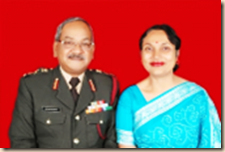 - Col (Dr) J Dutta & Dr Anjali Dutta
- Col (Dr) J Dutta & Dr Anjali Dutta
Contd from the last issue...
Motor Vehicle Fee
Motor Vehicle Fee stamps were issued by Indore state to collect taxes from motor vehicles. Fig-10 shows Motor Vehicle Fee stamp of Indore, value 100 rupees.
Fig-10
Telephone Service
Special stamps were issued for the telephone and telegraph services. Fig-11 shows a 3 annas Patiala State Telephone Service stamp.
Fig-11
Share Transfer
British India had special stamps that were required to be fixed to share certificates when they were transferred from one person to another. Fig-12 shows an 8-anna and Fig-13 shows a 1-rupee share transfer stamp.
Fig-12 Fig-13
Insurance Stamp
Insurance policies have special insurance stamps fixed on to them. Fig-14 shows a pair of King George V 2-annas insurance stamps and Fig-15 a post-independence 500-rupee.
Fig-14 Fig-15
Special Types
Special types of revenue stamps were used in some Indian states. Sirmor used postal stationery with provisional overprint for court fees. Fig-16 shows Sirmor Postcard overprinted for use as 8-annas Court Fee.
Fig-16
Stamped Papers
Collecting stamped papers is part of revenue philately. Stamped paper refers to a foolscap piece of paper that bears a pre-printed revenue stamp. Stamped papers have been used around the world to collect taxes on documents requiring stamping, such as leases, agreements, receipts, court documents and many others. The papers are bought blank apart from the pre-printed stamp and are available from stationers, lawyer’s offices, post offices and court stamp vendors according to local regulations. The matter to be recorded is then written or typed on to the stamped paper and it is lodged with the court or other interested party. This is an efficient way of collecting taxes and stamping documents without the need to submit them to a separate government stamp office.
The 1765 Stamp Act required all British colonies in the New World to use stamped paper prepared in London and embossed with a revenue stamp. This led to riots and political agitation which has been credited with sowing the seeds of the American Revolution.
Stamped paper was actually a Spanish invention and was introduced into India in 1848 following the introduction of the Congreve printing machine. Prior to this, legal documents were written on paper that could vary from strong parchment of good quality to ordinary stationers’ material. The use of water-marked paper came later. Prolific users of stamped paper have included Great Britain, the United States and India.
The stamp sometimes occupies the entire width of the top part of the paper and is often of an intricate engraved design in order to enhance security. The portrait of the ruling monarch was often part of the design. The paper frequently has a whole page watermark for the same reason. Figs-17&18 show British India King George V 12 Anna stamped paper used in 1938 & British India King George VI 150 rupees stamped paper used in 1943. Fig-19 shows 1934 5-rupee court fee stamp on 50 rupee Sangli State stamped paper and Figs-20&21 Bharatpur State 1anna stamp paper & Alipura State (India), stamped paper of 1900.
Fig-17
Fig-18 Fig-19
Fig-20 Fig-21
Collecting revenue stamps and stamped papers is an interesting and fun-filled hobby. While the stamps themselves are interesting, we find collecting them on the original document much more interesting. Especially fiscal stamps from the Princely States of India make colorful and interesting collections.
References
1. A Koeppel, R.D Manners, Court Fee and Revenue Stamps of the Princely States of India, Volume I – The Adhesive Stamps, Minneola, New York, 1983.
2. A Koeppel, R.D Manners, Court Fee and Revenue Stamps of the Princely States of India, Supplement to Volume I, Minneola, New York, 1986.
3. A Koeppel, R.D Manners, Court Fee and Revenue Stamps of the Princely States of India, Volume II – The Fiscal Stamp Paper, Minneola, New York, 1989.
4. Clive Akerman, The Presentation of Revenue Stamps: Taxes and Duties in South America. New edition. The Revenue Society of Great Britain, 2002.
5. Adolph Koeppel, The Stamps that Caused the American Revolution, the stamps of the 1765 British Stamp Act for America, American Revolution Bicentennial Commission, New York, 1976.
6. Einstein, Joseph; Thomas C. Kingsley and W. Richard DeKay. Handbook for United States Revenue Stamped Paper, American Revenue Association, Inc., United States.
7. SM Blatt, AM.Mollah, DH Heppell, Indian Government Fiscal and Judicial Stamps & Stamp Papers, Vol. 2, Part 1, 2004.
8. Jiří Černý, Revenue Stamps of the Princely States of India, 2009.
: Col Jayanta Dutta & Dr Anjali Dutta - email : doctorjayanta2009@gmail.com
Book Review
Review by Jeevan Jyoti
Collector's Guide to First Day Covers & Folders of India With Set of Stamps, Se-tenant Stamps & Miniature Sheets By Praful Thakkar Page 200 Price Rs 950 US$ 40 published by Kunal P. Thakar for Thakkar Numismatic & Art Foundation, Cary, NC USA.
The new book Collector's Guide to First Day Covers & Folders of India With Set of Stamps, Se-tenant Stamps & Miniature Sheets By Praful Thakkar is an essential book for all stamp lovers . It is a perfect guide for those who collect FDCs and Folders of India. The book gives listings and details of FDCs and Folders with Set of Stamps, Se-tenant stamps and Miniature Sheets. The book covers the period of FDCs and Folders of India from 1947 – 2012. The author has also covered FDCs and Folders of Definitive stamps and Overprinted Military stamps of India in this book.
The book is divided into 3 parts 1. Introduction 2.Catalogue and Checklists.
Introduction covers detailed explanation of creative varieties/variations and numbering system of set of stamps, se-tenant stamps and Miniature sheets.
In catalogue section information of respective stamps is given along with Print details and value. The section gives the details of FDCs and Folders with Set of stamps. FDCs and Folders with se-tenant stamps and FDCs and Folders with Miniature sheets.
In checklists section, total issue of commemorative stamps, set of stamps, se-tenant stamps & Miniature sheet, FDCs with set of stamps, Pre Independence India. FDCs with set of Commemorative, Definitive Regular, Definitive Military, Service, Se-tenant stamps, Miniature sheets and Presentation Packs have been given.
The book also covers rare Private First Day Covers with set of stamps of Pre Independence India all in color photos . In those days there were no official FDCs issued.
One can get complete details of FDCs of several categories. It will help the collectors to categorize their collection in the best possible way.
“ Simple Stamp is dumb,
when it is cancelled, it whispers,
but when it is having First Day Cancellation on First Day Cover it sings. ”
This is what this book proves to give details of the beautiful First Day Covers with a variety of stamp formats. I recommend this book to all philatelists and stamp collectors. It is the best reference book for collectors of FDC and Folders. This is the first book of its kind with pricing on FDCs and Folders of India with set of stamps, se-tenant stamps and Miniature sheets. The printing of the book is very fine with all color photos of FDCs and Folders including many rare items. In this book Valuation of various FDCs and Folders is given to give a basic guideline to the collectors. Pricing of different items mentioned in the book will certainly help the collectors to purchase their missing items at approximately reasonable price.
The book is available from :
Rekha P. Thakkar, 34 Janvisharam Society, Behind Sahjanand College, Ambawadi, Ahmedabad 380015 email : pkthakkar@yahoo.com Phone : 9327022642
Review by Naresh Agarwal
Collector’s Guide to First day Covers & Folders of India with Set of Stamps, Se-tenant Stamps and Miniature Sheets, Edition 2013 by Sri Praful Thakkar, a retired I.A.S officer, published by Kunal P.Thakkar for Thakkar Numismatic & Art Foundation , is a marvel for collectors of India Post Independence material like Stamps, Folders, Miniature and Souvenir sheets etc..
This book covers the period from 1947 to 2012 giving colored pictures of about 1800 FDCs, 450 folders, 2300 stamps and the miniature/souvenir sheets, all well presented in 200 pages. Through this book, Mr. Thakkar has tried to give a dimension to Philatelic facet of this period by very systematically cataloging Stamps. FDCs and Folders of this time. It will certainly prove to be a big source of information on Indian FDCs and Folders for all philatelists as this is first of its kind which gives so comprehensive, detailed, systematic, and chronological information of these philatelic items presented so beautifully issued so far by India Post. It illustrates the covers with the same design and with different color variations and gives sufficient technical information. Besides the First Day covers, various design of folders, presentation folders and souvenir albums have also been given in this book. The layout & design of the book is very good, attractive with high quality mat finish printing on imported glazed paper by high scam printing process.. It is an ideal reference book for all stamp collectors especially for FDCs collectors of Indian stamps.
Mr. Thakkar has given proper care in giving simplified identification numbers to each and every item keeping in view the numbers of Phila India. It is well garnished with various check lists and statistical data of each type of item separately such as FDCs, M/Ss etc. to have instant access and check. Effort has been done to give the present market sale pricing of individual item but it is felt that the pricing is not satisfactory. However, leaving aside the pricing part, the book will certainly prove to be a best reference book on the said items as it gives an idea as to how the collection would look like in totality and reality.
Also looking in to the quality and contents it has been very reasonably priced at Rs. 950/- Hence, is strongly recommended that every philatelic aspirant should have one piece in his possession.
About the author
 Shri Praful Thakkar is a noted collector of autographs, stamps, FDCs, coins, medals, tokens and badge plates and at present he is President of Gujarat Philatelists’ Association . As officer of Indian Administrative Service, he has served the Government of Gujarat for more than 31 years on various Posts at different places. He has participated in several National and International stamp exhibitions and has won many awards. His books, on autographs, philately, badge plates, Indian Canteen Tokens a, Membership Badges of Turf & Race Clubs of India are popular among collectors of these items. His two websites www.indiannumismatics.com & www.indianautographs.com are the great reference sites for the collectors of coins and autographs. He may be contacted at email : pkthakkar@yahoo.com
Shri Praful Thakkar is a noted collector of autographs, stamps, FDCs, coins, medals, tokens and badge plates and at present he is President of Gujarat Philatelists’ Association . As officer of Indian Administrative Service, he has served the Government of Gujarat for more than 31 years on various Posts at different places. He has participated in several National and International stamp exhibitions and has won many awards. His books, on autographs, philately, badge plates, Indian Canteen Tokens a, Membership Badges of Turf & Race Clubs of India are popular among collectors of these items. His two websites www.indiannumismatics.com & www.indianautographs.com are the great reference sites for the collectors of coins and autographs. He may be contacted at email : pkthakkar@yahoo.com
New Issues from other countries
National Unity stamps from Malaysia..
The glory of Malaysian unity was featured in a series of limited edition stamps issued on 26 March 2013 by Pos Malaysia.The values of compassion, consideration, co-operation and community are highlighted under four different themes. The stamps remind of the importance of unity not only among individuals, but also on a national level.
Pond Life stamps from Singapore
Singapore post issued a set of two stamps dedicated to ponds and pond life.
Ponds are teeming with both animal and plant life. It supports a large variety of animal and plant life such as birds, crayfish, small fishes, frogs, insects, algae and water lilies. In fact, a pond is a fascinating habitat to study. If a pond is to be a successful habitat, it must have aquatic plants growing in it as they provide food, oxygen and shelter for the animals. In this stamp issue two of these interesting pond plants are featured, namely the Geli Geli and the Water Gentian.
Geli Geli (Lasia spinosa) is an obscure member of the yam family. It is a perennial tropical and aquatic plant that thrives in a location with semi-shade to full sun. In can be found along the banks of rivers and in swamps and is tolerant of waterlogged conditions. Geli Geli is edible and possesses medicinal properties. Both the rhizomes and leaves possess expectorant properties and the leaves are used to treat coughs, stomachaches and various aches and pains.
Water Gentian (Nymphoides indica) is a pretty, fast-growing, perennial aquatic plant. A blooming colony looks like snow-flakes on water. It has flat, rounded, floating leaves and delicate white flowers with yellow centers. The petals have unusual, feathery edges. The flowers are formed above the floating leaves with 2-4 cm long stalks. It gets its common name, of floating hearts because of the heart-shaped, bright green leaves which lie on the water surface like those of water lilies.
The Lighter Side
Stamp with 111 faces
Swiss Post is launching a stamp featuring the portraits of 111 Swiss people. Swiss Post bridged the gap between one of its most traditional products, the stamp, and the digital world. An online competition was held to select 111 inhabitants of Switzerland whose faces were further immortalized on a stamp.
Participants had to upload their portrait onto the Swiss Post website or Facebook page until 9 December 2012. Finalists were randomly selected from amongst the uploaded photos.
During the second stage of the competition, finalists were chosen on their own merits. From 21 December 2012 until 2 January 2013 they battled it out in an online game to win one of the 111 places on the stamp. Participants who have successfully earned a place on the virtual stamp by the 2 January 2013 deadline were immortalized on the physical stamp.
1. Welcome to the World of Indian Philately - http://www.indianphilately.net/
An exclusive website created by Mr Prashant Pandya dedicated to Indian Philately .The philatelists can register for “ Online Philatelists’ Directory ” on this website.
2. Philatelic Journalists Forum - http://philatelicjournalistsforum.blogspot.in/ “The Philatelic Journalists” is an initiative by a few enthusiast philatelists, who love the hobby to the deepest.
3. Indian Philatelists’ Forum - http://groups.yahoo.com/group/indianphilatelists/
This is an electronic discussion forum dedicated exclusively to Indian Philately that allows members to engage into meaningful discussions on all aspects of Indian Philately. Membership to the forum is open to all philatelists who have interest in Indian Philately. Members can share and discuss their ideas, knowledge, research, collections, events, exhibitions, auctions, publications exclusively related to Indian Philately.
4. The best stamps - http://thebeststamps.blogspot.co.uk/ it’s a beautiful blog created by Julian Fernandes of Pune ( Now living in UK) featuring lovely stamps of birds with the photos of the same birds giving a wonderful look !!
5. Robin Stamps Criticism : http://robin-stamps.blogspot.in/ : This blog is about new issues of postage stamps and the critical study of their design
6.This Numismatic & Philatelic Association - http://numismaticphilavellore.site40.net/index.htm - This Numismatic & Philatelic Association is a nonprofit and non-trade motive association that aims to promote the hobbies – Philately (Stamp Collection) and Numismatics (Coin Collection) among children, students, interested individuals among the general public and especially for the budding philatelists and numismatists.
7. How to Collect Stamps - http://www.howtocollectstamps.com/ : The Complete Guide To Stamp Collecting
8.GANDHI Stamps & Philately Study Circle : http://gandhistampsclub.blogspot.in/ - A new Blog by Ketan Patel .…. Saving Gandhi Philately by trying to bring awareness and exposing illegal activities in Gandhi Stamps and Philately.
9. Europa Stamps : http://europa-stamps.blogspot.in/ : A blog on Europa, cept, norden & sepac stamps
10. Phila Mirror : http://philamirror.info/ : The Indian Philately Journal
11. Se- tenant Stamps of India - http://setenantsofindia.blogspot.com/ It is a specialized Blog on se-tenant stamps.
12. Flags & Stamps - http://flagstamps.blogspot.com/ - It is a specialized blog on Flag Theme .
13. Glimpses of Modern Indian Philately : http://modernindianphilately.blogspot.com/ - It is a specialized blog on Modern Philately, created by Mr Prashant Pandya .
14. Join Mobile Philately & Stay Updated - http://mobilephilately.blogspot.com/ Mobile Philately is a mobile technology based philatelic community with short messaging service (SMS) that allows the community members to get latest updates related to Indian philately directly into mobile message box.
15. Question & Answers on Philately : http://en.allexperts.com/q/Stamps-Philately- 1610/indexExp_69442.htm - It is a site based on Question & Answers on Philately. Mr Prashant Pandya replies to queries.
Literature on Indian Philately
View : List of Books 1
Editor’s Mail Box
- Arun Tendulkar, Mumbai
Congratulations on winning a well-deserved medal at the recently held Inpex 13 in Mumbai . IT is a just recognition of the efforts you have put in making RAINBOW a resounding success in a short span by including articles touching various aspects of philately . May your subscriber list grow. With best wishes for future.
- Pradip Jain, Patna
Heartiest congratulation for the National Vermeil Award to Rainbow which is very well deserve and reward of your all good work and remain connected to the Philately world especially when there is no any National statures Magazine is there to read. Your presence and contribution is highly praiseworthy. Keep it up the spirit .
I read your reporting for Inpex - 2013 which is very well covered news.
Acknowledgement
Vadophil Januray 2013 issue : http://www.vadophil.org/index.htm
Todywalla Auction Catlogue No 5
www.todywalaauction.com email : info@todyauction.com
Auction Catalogue : Philatelic Centre ( Saturday 6th April 2013)
www.philcent.com email : philcent@rediffmail.com
Philatelic Clubs & Societies
Baroda Philatelic Society - http://www.vadophil.org/
Deccan Philatelic Society – Pune, Maharashtra
Eastern India Philatelists’ Association - http://www.filacapsule.blogspot.com/
India Study Circle - http://www.indiastudycircle.org/
Indian Stamp Ghar - http://www.indianstampghar.com/
Indian Thematic Society, Ludhiana - http://indianthematicstamps.webs.com/
Ludhiana Philatelic Club
Mobile Philately - http://www.mobilephilately.webs.com/
Numismatic & Philatelic Association of Vellore Fort http://numismaticphilavellore.site40.net/index.htm
Philatelic Society of Rajasthan, Jaipur
Rainbow Stamp Club - http://rainbowstampclub.blogspot.com/
Rajkot Philatelic Society – Rajkot, Gujarat
Gujarat Philatelic Association - Ahmedabad
South India Philatelists Association - http://www.sipa.org.in/
Stamps of India - http://www.stampsofindia.com/
The Army Philatelic Society, Pune
Current Philatelic Magazines – Newsletters
Stamp of India Collectors’ Companion - India’s first weekly e-newsletter edited by Madhukar and Savita Jhingan from Stamps of India, New Delhi. E-mail: mjhingan@yahoo.com Website: www.stampsofindia.com
India Post – Quarterly Journal of the India Study Circle publishes original articles submitted by members of ISC.
ITS Stamp News - Quarterly - Editor: Suraj Jaitly Publisher: Indian Thematic Society website - http://itsstampnews.blogspot.com/
Phila News, Editor Rajesh Pahariya and published by Philatelic Society of Rajasthan, Jaipur
VADOPHIL, Editor - Prashant Pandya and published by Baroda Philatelic Society, Vadodara. Website -http://www.vadophil.org/
Journal of the Army Philatelic Society : Editor – Col Jayanta Dutta
e ZEP Newsletter http://www.ezep.de/zpj/zpj.html Editor : Dieter Leder email zpj@arcor.de website www.eZEP.de
SIPA Bulletin Editor - Mr G. Madan Mohan Das and published by South India Philatelists’ Association, Chennai website : http://www.sipa.org.in/
FILA Capsule – Editor : Ajit Dash and published by EIPA, Bhubaneshwar.
GPA News – Editor- Ilias Patel and published by Gujarat Philatelists’ Association, Ahemadabad.
Kar Phila News published by Karnataka Philatelic Society & edited by by Akshay Borad
e–mail : akshayborad@hotmail.com \
RAINBOW STAMP CLUB
This is a blog of e-stamp Club www.rainbowstampclub.blogspot.com . The idea of this blog is to extend philatelic fraternity in all corners of the world. Readers may write about themselves with their collecting interests and share new ideas with other philatelists. New Post on recent issues, news on stamp activities and Contribution by members are published every day on this blog.
Readers may also express their views on any philatelic matter which will be published under Club News at Rainbow Stamp Cub Blog. Philatelic Clubs and Societies may also send brief write ups. News about new issues of India and abroad and other information related with Philately are regularly posted on this blog. Readers may send reports on new issues, special covers, cancellations & philatelic activities of their area for inclusion in this Blog. - Editor
Courtesy - News and Image Resource to this issue –Stamps of India, International Stamp News ; Mansoor B.- Mangalore Prashant Pandya – Vadodara; Bhumika Sharma - Solan ; Raj Kumar Chaudhary – Jamshedpur; Kenneth Sequeira – Dubai; Sreejesh Krishnan, Trivandrum; Ajit Dash, Bhubaneshwar
All the images of this issue have not been included here. For detailed images related to this issue Please Visit: http://www.rainbowstampnews.blogspot.com/
Address for communication:
Jeevan Jyoti, c / o Mr. Ajay Srivastav, Chief Conservator of Forests, GHNP & Pin Valley National Park, Shamshi, Kullu (H.P.) PIN 175126 India
E-mail – j.jyoti9@gmail.com or rainbowstamp2008@gmail.com
![]() Last date for receiving write ups – 25th of every month. Kindly send images in jpg compressed format & text in MS Word only.
Last date for receiving write ups – 25th of every month. Kindly send images in jpg compressed format & text in MS Word only.
![]() If you liked this issue please forward it to your friends and help in promoting philately.
If you liked this issue please forward it to your friends and help in promoting philately.
A Request to Readers & Contributors -
![]() Please do not send the text in scan form or PDF. Send your write ups in MS Word only.
Please do not send the text in scan form or PDF. Send your write ups in MS Word only.
Kindly specify your contribution such as article/News/ Reader’s Right / Beginners’ Section/ Lighter Side etc.
![]() Please do not send forwarded messages for promotional section if you want to give any information for promotion please write personally with brief write up. As this newsletter is not used for any commercial purpose in any manner.
Please do not send forwarded messages for promotional section if you want to give any information for promotion please write personally with brief write up. As this newsletter is not used for any commercial purpose in any manner.
Attention -
Please send limited number of images in compressed jpg format only with your article. Please send text and images separately. Please do not send text or image for publication in PDF.
Any material from this newsletter may be reproduced only with the written permission from the editor.
…..Happy Collecting…………………………………………………………………
Rainbow Stamp News is edited and published monthly by Jeevan Jyoti, from Kullu (Himachal Pradesh) India.




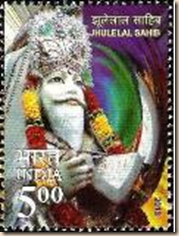
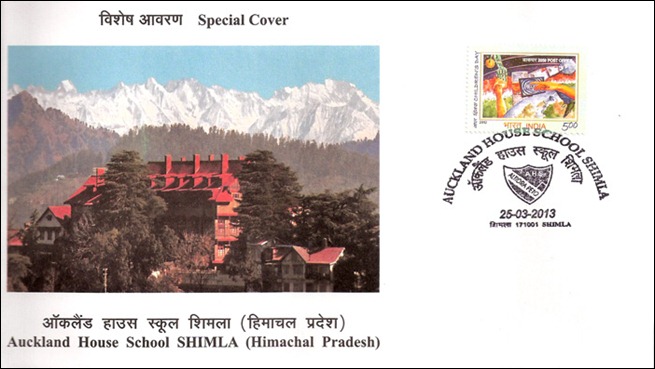

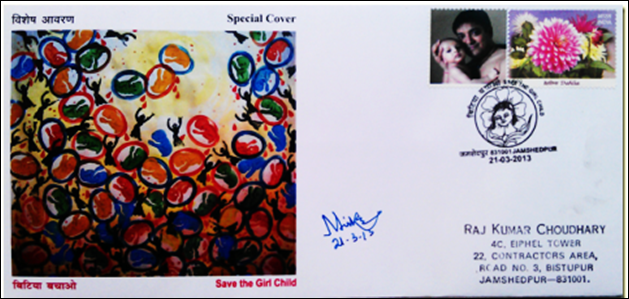
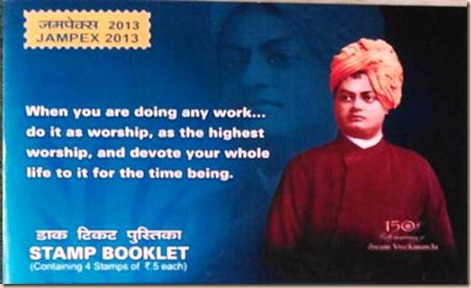
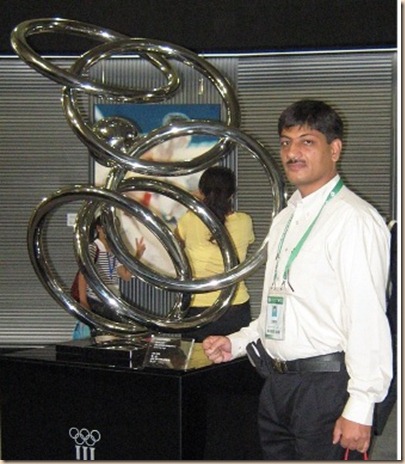




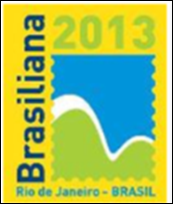



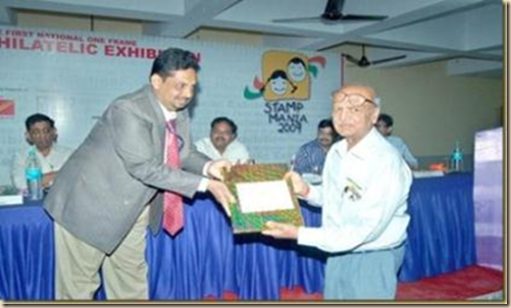




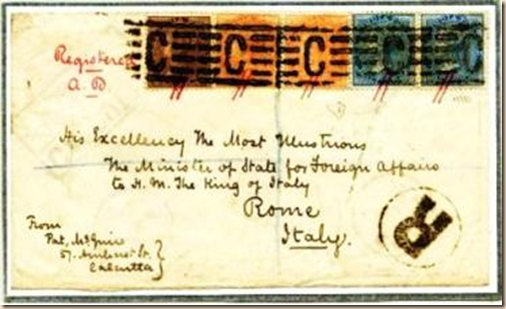

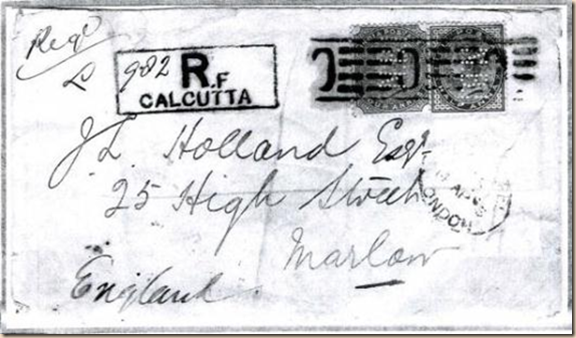
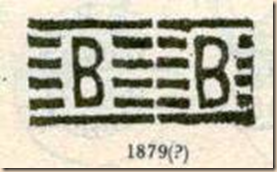
![clip_image064_thumb[2] clip_image064_thumb[2]](http://lh4.ggpht.com/-g36YxbMACtM/UVfn1yyReXI/AAAAAAAAZPI/3QJAC2Ln4gI/clip_image064_thumb2_thumb1.jpg?imgmax=800)
